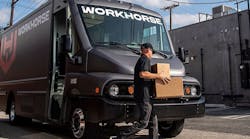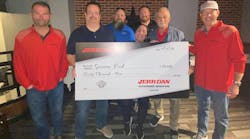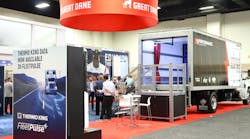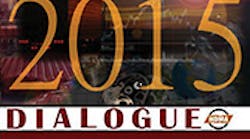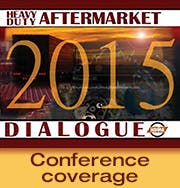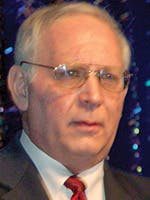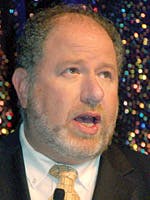BOB Dieli thinks the trucking industry is in very good shape—at least based on Truckable Economic Activity (TEA).
In his presentation, “The Fundamental Drivers of the Industry,” Dieli—the president and founder of RDLB Inc—said TEA measures what’s moving by truck and has five components: consumption (durable and nondurable consumer goods); investment (all spending on structures, plant and equipment, and the absolute change in inventories); exports; imports; and government.
He said TEA has been making steady progress from 2009-2014 and is tracking almost identically to the longest expansion period (1991-2001).
“It might be time to stop saying bad things about this expansion,” he said.
Dieli said the trucking sector depends on Truckable Fixed Investment, which is spending on plants and equipment, trucks, and construction.
“That got off to a slow start (when the recovery began) because the construction sector was still contracting, but it’s been picking up steam over the past two years,” he said. “Compared to the 1982 expansion, it’s a completely different pattern. The tax laws passed in 1981 included provisions on leasing that were extremely liberal, which led to spending on all sorts of leased equipment, and it was reflected in Truckable Economic Activity. But as the effects wore off, the line flattened off. As of right now, we’re doing more or less the same thing.”
State and local government budgets got hammered because employment went down and with it, the income tax they could collect, and the sales tax they could collect that went down as spending collapsed.
“In this current cycle, there has been no progress made in state and local activity,” Dieli said. “If you’re having trouble selling school buses, this is why. For a long time, they had no money to spend and had to balance their budgets.
“Over time, we’ve seen tremendous shifts in the shares of Truckable Economic Activity. This is not your father’s TEA. Look at the share of exports and imports in this cycle from 2009-2014: 24%. It’s the same as investment. If you’re not doing business with people who are in the process of engaging in the foreign sector, you’re probably missing an opportunity. Government spending has changed only 1% since 1991.”
In terms of trucks, Dieli said Class 8 sales in October 2014 (22,032) were virtually identical to those of July 2006 (22,336), but the market shares have changed a lot: Freightliner has gone from 28.3% to 37%; Mack has gone from 9.4% to 6.8%; International has gone from 17.5% to 15.9%; and Peterbilt has gone from 14.7% to 13.9%.
“In the case of Mack, that change is the result of housing and construction. In the case of International, some of it has to do with technical issues, engines, and so forth, but the fact remains that the total didn’t change but shares changed greatly, and that’s another way to track structural change.”
How will the economy influence the trucking sector this year?
• The expansion phase is likely to continue through 2015.
• Major changes in fiscal and monetary policy are possible in the near term because of realignment of the Senate and announcements by the Federal Reserve of a change in operating procedures and priorities.
• Events overseas will continue to be a major influence on both the course of aggregate economic growth and the decisions made by the Federal Reserve.
He said the economy is struggling to recover from downturn because the country is facing some extremely serious problems that he put into a medical analogy.
• Heart attack. “The housing market was broken. This was like a heart attack for the economy.”
• Stroke. “There was a catastrophic, and, some would say, cataclysmic collapse in full-time employment. We dropped close to 12 million jobs, and that completely changed the nature of the labor market. Today is different from when the recession started. This problem is large. We’ve overcome some of it but have a lot of work to do.”
• Blood clot. “There was a rise of part-time employment for economic reasons. Bureau of Labor statistics define part-time employment as people who work 35 hours or less. Of the seven million people who are part-time or unemployed, almost six million of those are part-time for economic reasons, meaning their hours are being cut back. The others are people who can only find part-time work. This has never happened before, and it has changed the dynamic of wages and employment itself. The Bureau of Labor is looking into the effects of the Affordable Care Act, which is defining full- and part-time employees for insurance coverage in ways that we think are affecting the willingness to hire full-time employees. We don’t know about this for sure, but we think it is a factor. But the symptoms were in place earlier.”
• Divorce. “Political ill will. The net result is that many of these problems are not being addressed in any serious form. This also marks a departure from other recoveries where there was more political focus on what we were going to do about the economy. For us as a whole, having our parents bicker over whether one party will drive us to the hospital for treatments for the blood clot or someone else will, doesn’t really help. It’s like divorcing parents arguing about who will take the patient to the ER.”
He quoted Janet Yellen, chairman of the Federal Reserve, from last December’s meeting, talking about the next steps in monetary policy:
“To support continued progress toward maximum employment and price stability, the Committee today reaffirmed its view that the current 0 to 1/4 percent target range for the federal funds rate remains appropriate.”
Said Dieli, “The Federal Funds Rate historically rises in front of recessions, so there are no recessions that don’t have the Fed’s palm prints on its back. The US economy grows unless it’s restrained, and the principal source of restraint is monetary policy in the short run.
“The economy has been expanding for 67 straight months. In all other expansions that have lasted this long, the Fed has raised, and, in some cases, lowered rates with the economy continuing to expand. So I advise you to ignore all the folks who will tell you that when the Feds change rates, the economy will roll over. No. The economy can continue just fine, thank you.”
He said Yellen has stated there are two steps in the monetary policy:
• Civilian full-time employment maximum employment.
“We are still 2,393,000 below the pre-recession peak. We have not taken up the prior cycle peak. If you add in all the part-time people, the question becomes, ‘Do we want to count part-time people as essentially the full-time equivalent or use them as a way to access where we are in terms of the level of employment?’ ”
• Inflation rate of 2%.
“We don’t have it. Inflation is to the economy what your blood pressure is to your vital signs. If your blood pressure gets too high, you have a stroke and die. If it’s too low, you’ll get kidney failure and you’ll die. So your doctor wants your blood pressure to be in the normal ranges. It’s the same thing with inflation. If it’s too high, it indicates there are serious problems in the way goods and services are being priced that affect how they’re bought and how investors behave. But if prices are too low, you have no pricing power, and how do you run your business? The Fed is using this 2% as the normal blood pressure in the economy. Right now, we’re running below 2% largely because of falling energy prices. But over a long time, the economy works better if it’s in the normal ranges.”
Bill Strauss
Senior economist, Federal Reserve Bank of Chicago
He said when we think about GDP, it will probably be slightly above trend for the year.
“The biggest news was the drop in energy prices and turmoil in developing countries—Russia and Brazil,” he said. “China’s growth is slowing. India is in growth, but not enough to offset other countries. Europe has maybe only 1% growth. The US is just under 3% for this year and next year.”
He said people think an interest-rate rise is bad news, but we need to realize rate hikes are like “taking the training wheels off the economy.” ♦
Find the Heavy Duty Aftermarket Dialogue Report archive with articles from 2012 to present




